Static Voltage Sharing Design of a Sextuple-Break 363 kV Vacuum Circuit Breaker †
Abstract
:1. Introduction
2. Structure of the 363 kV Circuit Breaker
2.1. Determination of the Number of Breaks
2.2. Structure Design
3. Finite Element Method (FEM) Model and Voltage Distribution Calculation
4. Grading Capacitor Design
5. Breaking Test of the 363 kV VCB
6. Summary and Conclusions
Author Contributions
Funding
Conflicts of Interest
References
- Chen, H.; Liu, X.; Li, L.; Liu, Y.; Zhang, Y.; Huang, Y. Analysis of Dynamic Arc Parameters for Vacuum Circuit Breaker Under Short-Circuit Current Breaking. IEEE Trans. Appl. Supercond. 2019, 29, 1–5. [Google Scholar] [CrossRef]
- Yao, X.; Wang, J.; Geng, Y.; Yan, J.; Liu, Z.; Yao, J.; Liu, P. Development and type test of a single-break 126-kV/40-kA–2500-A vacuum circuit breaker. IEEE Trans. Power Deliv. 2016, 31, 182–190. [Google Scholar] [CrossRef]
- Liu, H.; Wang, Z.; Yang, J.; Li, B.; Ren, A. Circuit Breaker Rate-of-Rise Recovery Voltage in Ultra-High Voltage Lines with Hybrid Reactive Power Compensation. Energies 2018, 11, 100. [Google Scholar] [CrossRef]
- Franck, C.M. HVDC circuit breakers: A review identifying future research needs. IEEE Trans. Power Deliv. 2011, 26, 998–1007. [Google Scholar] [CrossRef]
- Jankowski, P.; Mindykowski, J. Study on the Hazard Limitation of Hybrid Circuit Breaker Actuator Operation. Energies 2018, 11, 416. [Google Scholar] [CrossRef]
- Zhang, B.; Ren, L.; Ding, J.G.; Wang, J.; Liu, Z.; Geng, Y.; Yanabu, S. A Relationship between Minimum Arcing Interrupting Capability and Opening Velocity of Vacuum Interrupters in Short-circuit Current Interruption. IEEE Trans. Power Deliv. 2018, 33, 2822–2828. [Google Scholar] [CrossRef]
- Tan, Y.; Kun, Y.; Xiang, B.; Wang, J.; Liu, Z.; Geng, Y.; Yanabu, S. Repulsion mechanism applied in resistive-type superconducting fault current limiter. IEEE Trans. Appl. Supercond. 2016, 26, 1–9. [Google Scholar] [CrossRef]
- He, Z.; Wang, S. Design of the electromagnetic repulsion mechanism and the low-inductive coil used in the resistive-type superconducting fault current limiter. IEEE Trans. Appl. Supercond. 2014, 24, 1–4. [Google Scholar] [CrossRef]
- Hou, C.; Yu, X.; Cao, Y.; Lai, C.; Cao, Y. Prediction of synchronous closing time of permanent magnetic actuator for vacuum circuit breaker based on PSO-BP. IEEE Trans. Dielectr. Electr. Insul. 2017, 24, 3321–3326. [Google Scholar] [CrossRef]
- Homma, M.; Sakaki, M.; Kaneko, E.; Yanabu, S. History of vacuum circuit breakers and recent developments in Japan. IEEE Trans. Dielectr. Electr. Insul. 2006, 13, 85–92. [Google Scholar] [CrossRef]
- Cheng, X.; Chen, S.; Ge, G.; Wang, H.; Wu, Q. Investigating on Synergy Effect of Series-Connected Vacuum Arcs in Multi-break VCBs. In Proceedings of the 2018 28th International Symposium on Discharges and Electrical Insulation in Vacuum (ISDEIV), Greifswald, Germany, 23–28 September 2018; Volume 2, pp. 671–674. [Google Scholar]
- Ge, G.; Liao, M.; Duan, X.; Cheng, X.; Zhao, Y.; Liu, Z.; Zou, J. Experimental investigation into the synergy of vacuum circuit breaker with double-break. IEEE Trans. Plasma Sci. 2016, 44, 79–84. [Google Scholar] [CrossRef]
- Huang, D.; Wu, G.; Ruan, J. Study on Static and Dynamic Voltage Distribution Characteristics and Voltage Sharing Design of a 126-kV Modular Triple-Break Vacuum Circuit Breaker. IEEE Trans. Plasma Sci. 2015, 43, 2694–2702. [Google Scholar] [CrossRef]
- Horn, A.; Lindmayer, M. Investigations on the series connection of two switching gaps in one tube in vacuum. IEEE Trans. Plasma Sci. 2005, 33, 1594–1599. [Google Scholar] [CrossRef]
- Zhang, B.; Tan, Y.; Ren, L.; Wang, J.; Geng, Y.; Liu, Z.; Yanabu, S. Interruption Capability of a Fast Vacuum Circuit Breaker with a Short Arcing Time. In Proceedings of the XXVIIth International Symposium on Discharges and Electrical Insulation in Vacuum, Suzhou, China, 18–23 September 2016; pp. 1–4. [Google Scholar]
- Huang, D.; Shu, S.; Ruan, J. Transient recovery voltage distribution ratio and voltage sharing measure of double-and triple-break vacuum circuit breakers. IEEE Trans. Compon. Packag. Manuf. Technol. 2016, 6, 545–552. [Google Scholar] [CrossRef]
- Ge, G.; Cheng, X.; Liao, M.; Huang, Z.; Zou, J. Mechanism of dynamic voltage distribution in series-connected vacuum interrupters. IEEE Trans. Plasma Sci. 2018, 46, 3083–3089. [Google Scholar] [CrossRef]
- Fugel, T.; Koenig, D. Influence of grading capacitors on the breaking performance of a 24-kV vacuum breaker series design. IEEE Trans. Dielectr. Electr. Insul. 2003, 10, 569–575. [Google Scholar] [CrossRef]
- Sugita, M.; Igarashi, T.; Kasuya, H.; Okabe, S.; Matsui, Y.; van Lanen, E.; Yanabu, S. Relationship between the voltage distribution ratio and the post arc current in double-break vacuum circuit breakers. IEEE Trans. Plasma Sci. 2009, 37, 1438–1445. [Google Scholar] [CrossRef]
- Shaogui, A.; Xiao, Y.; Yongning, H.; Fan, Y.; Yiping, F.; Xing, L. Voltage Distribution Design of a Novel 363 kV Vacuum Circuit Breaker. In Proceedings of the 2018 IEEE International Conference on High Voltage Engineering and Application (ICHVE), ATHENS, Greece, 10–13 September 2018; pp. 1–4. [Google Scholar]
- Grading Capacitors for High-Voltage Alternating Current Circuit Breakers. Available online: https://infostore.saiglobal.com/preview/is/en/2014/i.s.en62146-1-2014%2Ba1-2016.pdf?sku=1723996 (accessed on 21 May 2019).
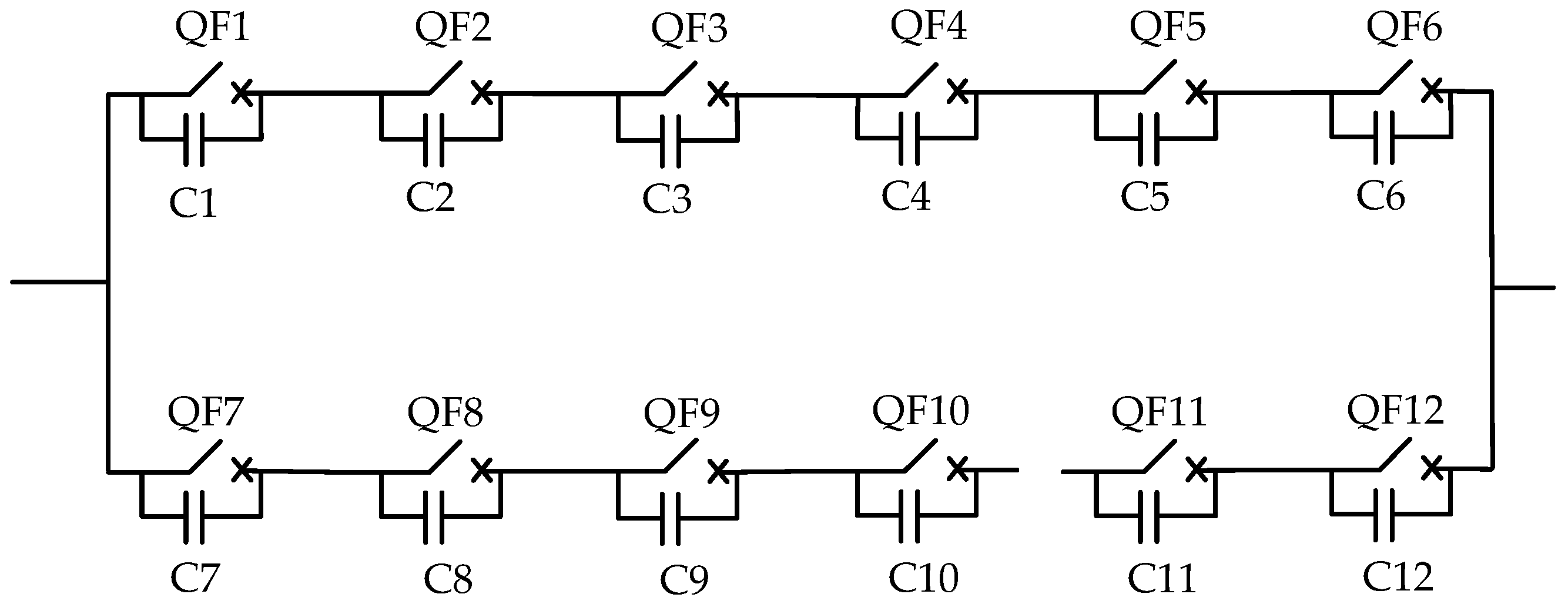
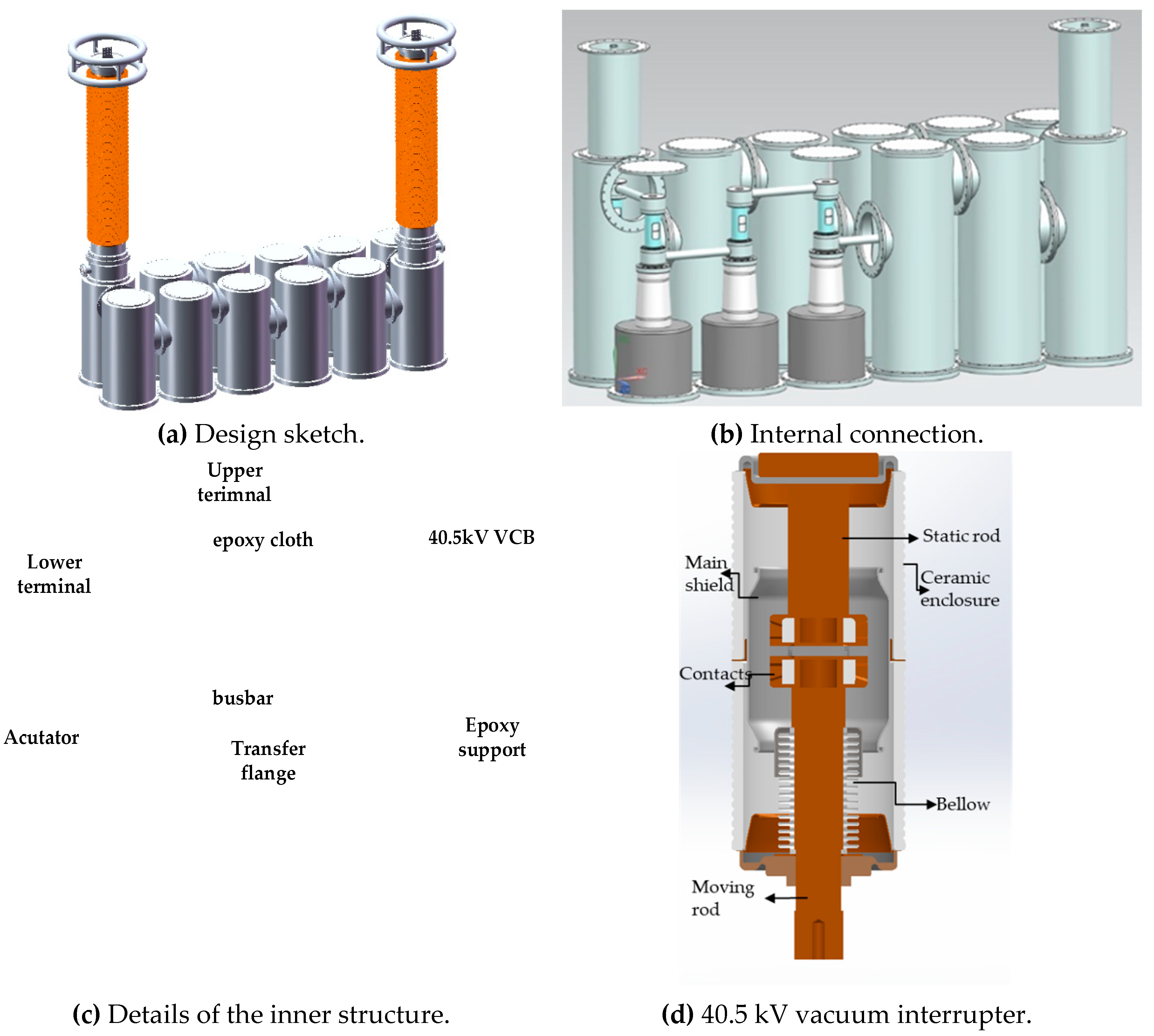
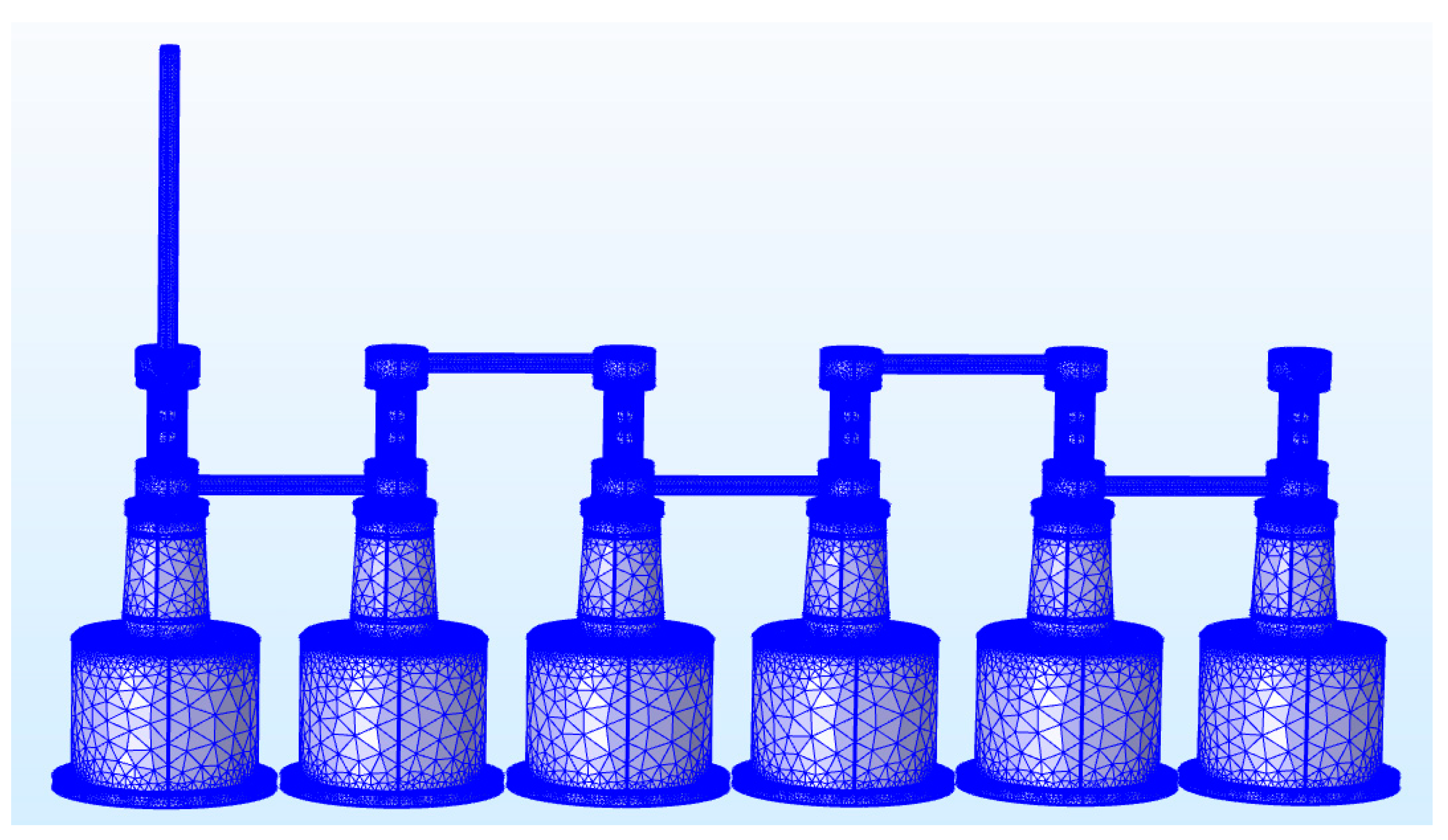
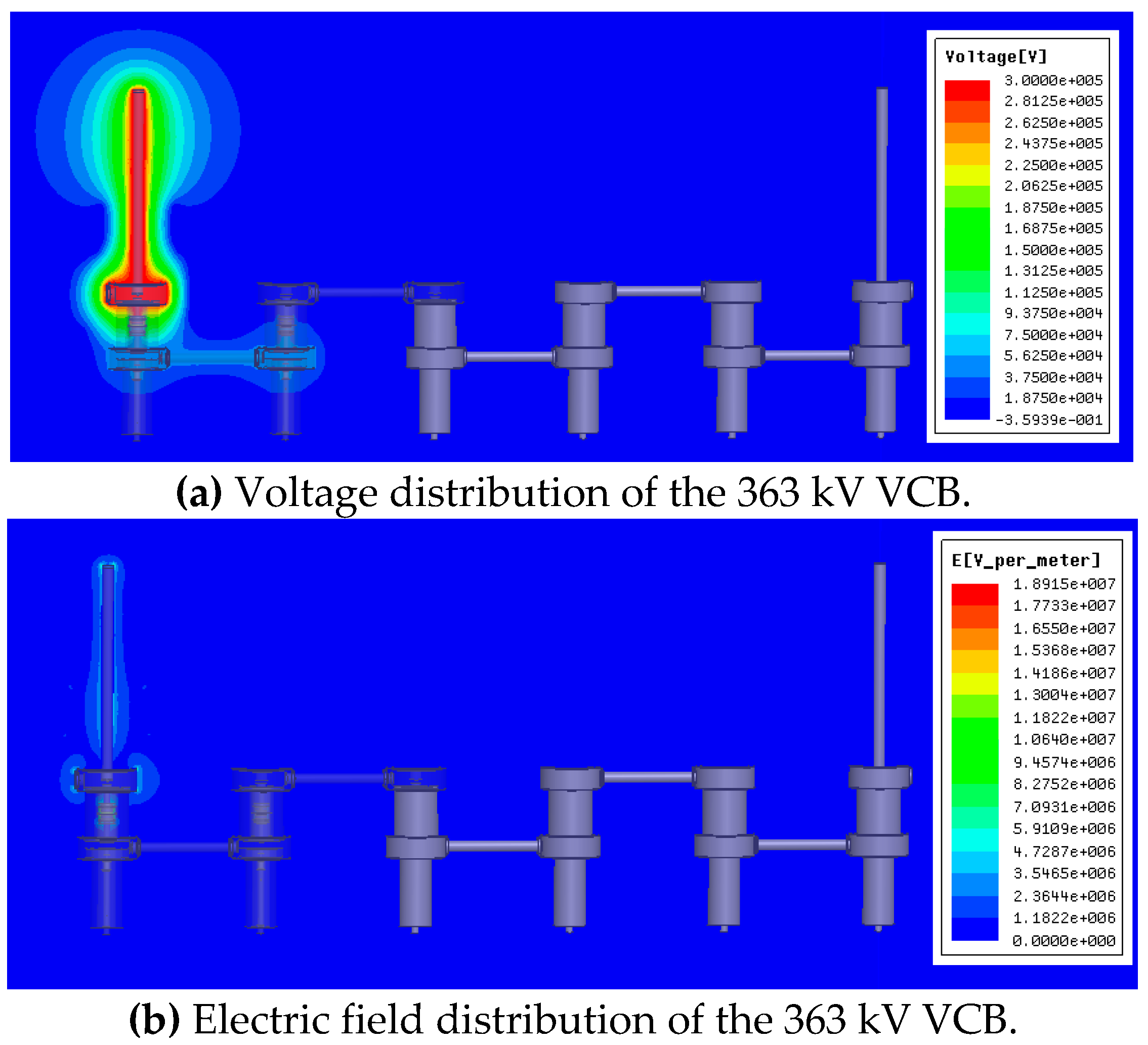


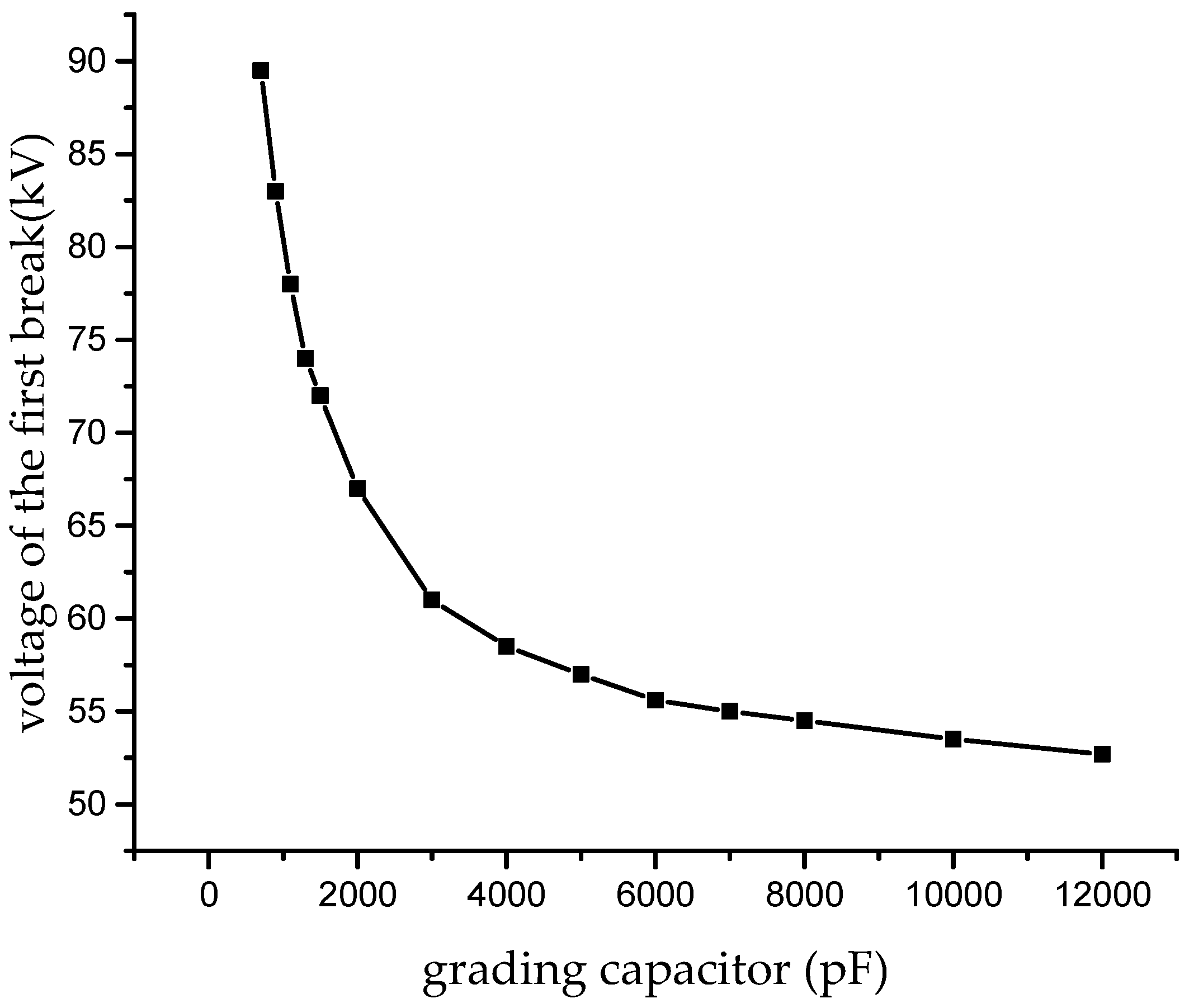
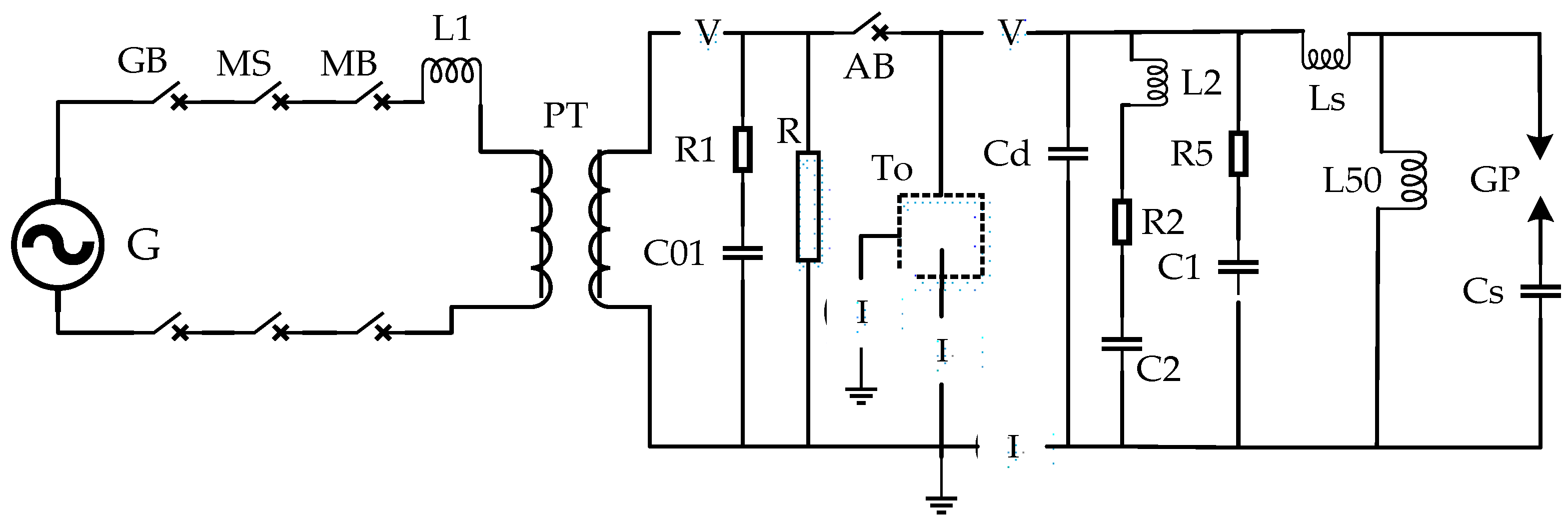
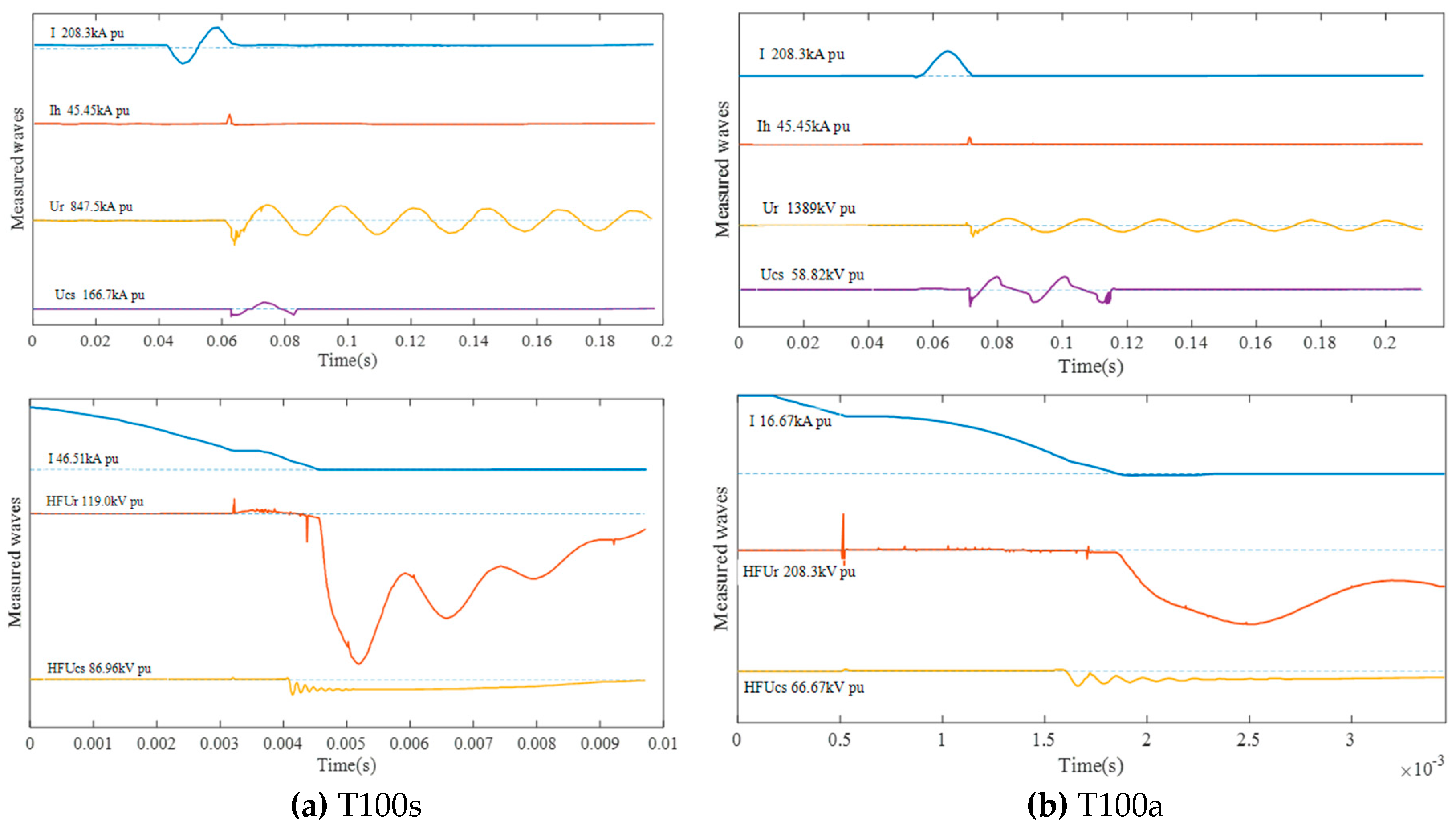

| Parameter Name | Value |
|---|---|
| Tank radius | 410 mm |
| Tank height | 2047 mm |
| Busbar external radius | 80 mm |
| Upper and lower terminal radius | 156 mm |
| Transfer flange radius | 245 mm |
| Part Name | Size |
|---|---|
| Moving contact | Radius = 25 mm, length = 190 mm |
| Static contact | Radius = 25 mm, length = 105 mm |
| Contact | Radius = 40 mm, thickness = 30 mm, round radius = 4 mm |
| Ceramic envelope | Radius = 35.5 mm, thickness = 8.5 mm |
| Ceramic envelope | External radius = 240 mm, internal radius = 200 mm, height = 378 mm |
| Break | Voltage | Voltage Distribution Ratio (%) |
|---|---|---|
| V1 | 256 kV | 86.3% |
| V2 | 35.18 kV | 11.73% |
| V3 | 5.03 kV | 1.68% |
| V4 | 0.684 kV | 0.23% |
| V5 | 0.0982 kV | 0.032% |
| V6 | 0.0153 kV | 0.00% |
| Grading Capacitor (pF) | Voltage of the First Break (kV) |
|---|---|
| 700 | 89.4 |
| 900 | 83 |
| 1100 | 78 |
| 1500 | 72 |
| 2000 | 67 |
| 4000 | 56 |
| 6000 | 55 |
| 7000 | 55 |
| 8000 | 54.5 |
| 10,000 | 53.5 |
| 12,000 | 52.7 |
| Test Parameters | 63 kA | 80 kA | ||
|---|---|---|---|---|
| T100s | T100a | T100s | T100a | |
| Charging voltage | 512 kV | 460 kV | 487 kV | 471 kV |
| Breaking current | 64 kA | 63.7 kA | 73.5 kA | 80.2 kA |
| di/dt | 28 A/us | 24.4 A/us | 35.5 A/us | 35.5 A/us |
| Recovery voltage | 258 kV | 228 kV | 254 kV | 246 KV |
| TRV peak | –544 kV | –484 kV | –542 kV | –526 kV |
| Th | 461 us | 230 us | 200 us | 233 us |
© 2019 by the authors. Licensee MDPI, Basel, Switzerland. This article is an open access article distributed under the terms and conditions of the Creative Commons Attribution (CC BY) license (http://creativecommons.org/licenses/by/4.0/).
Share and Cite
Yu, X.; Yang, F.; Li, X.; Ai, S.; Huang, Y.; Fan, Y.; Du, W. Static Voltage Sharing Design of a Sextuple-Break 363 kV Vacuum Circuit Breaker. Energies 2019, 12, 2512. https://doi.org/10.3390/en12132512
Yu X, Yang F, Li X, Ai S, Huang Y, Fan Y, Du W. Static Voltage Sharing Design of a Sextuple-Break 363 kV Vacuum Circuit Breaker. Energies. 2019; 12(13):2512. https://doi.org/10.3390/en12132512
Chicago/Turabian StyleYu, Xiao, Fan Yang, Xing Li, Shaogui Ai, Yongning Huang, Yiping Fan, and Wei Du. 2019. "Static Voltage Sharing Design of a Sextuple-Break 363 kV Vacuum Circuit Breaker" Energies 12, no. 13: 2512. https://doi.org/10.3390/en12132512





